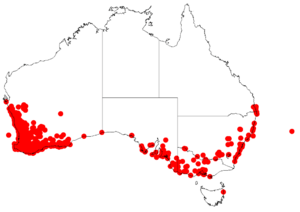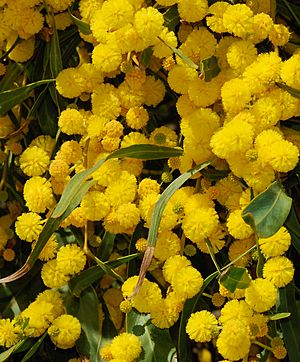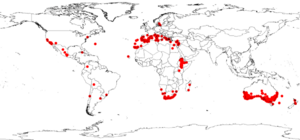Coojong facts for kids
Quick facts for kids Coojong |
|
|---|---|
 |
|
| Scientific classification | |
| Genus: |
Acacia
|
| Species: |
saligna
|
 |
|
| Australian occurrence data from AVH | |
| Synonyms | |
|
Acacia cyanophylla Lindley |
|
Acacia saligna, often called Coojong or Golden Wreath Wattle, is a small tree from the Fabaceae family, which includes peas and beans. It comes from Australia, especially the southwestern part of Western Australia. The Noongar people, who are Indigenous Australians, call this tree Cujong. In Africa, it is sometimes known as Port Jackson Willow.
Contents
What is Coojong?
The Coojong tree grows to about eight metres tall. It has a short trunk and branches that spread out, often looking like they are weeping or hanging down.
Like many Acacia trees, Coojong has special leaf-like structures called phyllodes instead of true leaves. These can be up to 25 centimetres long. At the bottom of each phyllode, there is a small gland that makes a sugary liquid. This liquid attracts ants, which helps protect the tree by reducing the number of insects that eat its leaves.
In late winter and early spring, the Coojong tree gets bright yellow, round flowers. These flowers grow in groups of up to ten. After flowering, the tree produces a fruit called a legume, which is like a pod. Inside the pods are oblong seeds that are dark or black.
Coojong is a natural pioneer plant. This means it often grows in places where the soil has been disturbed, like next to new roads. Ants help spread its seeds by carrying them to their nests to eat the seed-stalks. When the soil is disturbed, these seeds can come to the surface and start to grow. Coojong seeds sprout easily, and you can often find many young plants under one parent tree. Young Coojong trees also grow very fast, sometimes more than a metre each year!
How People Use Coojong
Coojong trees can be used for many different things because they can grow well in many types of soil.
Here are some ways Coojong has been used:
- Tanning: Its bark can be used to make leather.
- Revegetation: It helps bring plant life back to areas where it has been lost.
- Animal Food: Some parts of the tree can be used as food for animals.
- Mine Site Repair: It helps fix land that has been damaged by mining.
- Firewood: Its wood can be burned for fuel.
- Mulch: It can be used to cover soil, helping it stay moist and healthy.
- Agroforestry: It can be grown alongside crops or livestock.
- Decoration: It is also planted as a beautiful garden plant.
Coojong has been planted a lot in dry areas of Africa, South America, and the Middle East. It helps create windbreaks to protect against strong winds and helps stop sand dunes from moving or soil from washing away.
When Coojong Becomes a Problem
Outside of its natural home in Australia, Acacia saligna can become an invasive species. This means it spreads very quickly and can take over areas, harming native plants and ecosystems.
Here are some reasons why Coojong can become invasive:
- It was planted widely in many places outside Australia.
- It grows very fast even in poor soil.
- It starts making seeds at a young age.
- It produces a huge number of seeds.
- Its seeds can survive fires.
- It can regrow even after being cut down or burned.
- It can grow in many different types of soil.
- It can add nitrogen to the soil, which changes the soil conditions.
- It has a very large root system.
- It can grow much taller than local plants, sometimes by more than 3 metres.
For example, in the 1950s, people in Sydney, Australia, planted Coojong because they thought it was a good native plant. However, it has since become a major weed in eastern New South Wales, Victoria, and South Australia.
Coojong's Impact in South Africa
In South Africa, Coojong spread out of control. It was brought there in the 1800s to produce bark for tanning and to help stabilize the sandy areas near Cape Town. Before this, many of the local plants had been cut down for firewood.
Coojong not only replaced the native fynbos plants (a type of shrubland), but it also made farming harder. It is now listed as an invasive plant in the Cape Floristic Region of South Africa. It changes how fires behave in the area, which further harms native species.
To control Coojong, scientists have introduced a special fungus called Uromycladium tepperianum. This fungus has been very effective, reducing the number of Coojong trees by 80%. Another insect, the acacia seed weevil (a type of Melanterius), was introduced in 2001 and is now helping to control the spread of Coojong seeds.
See also
 In Spanish: Acacia de hoja azul para niños
In Spanish: Acacia de hoja azul para niños



